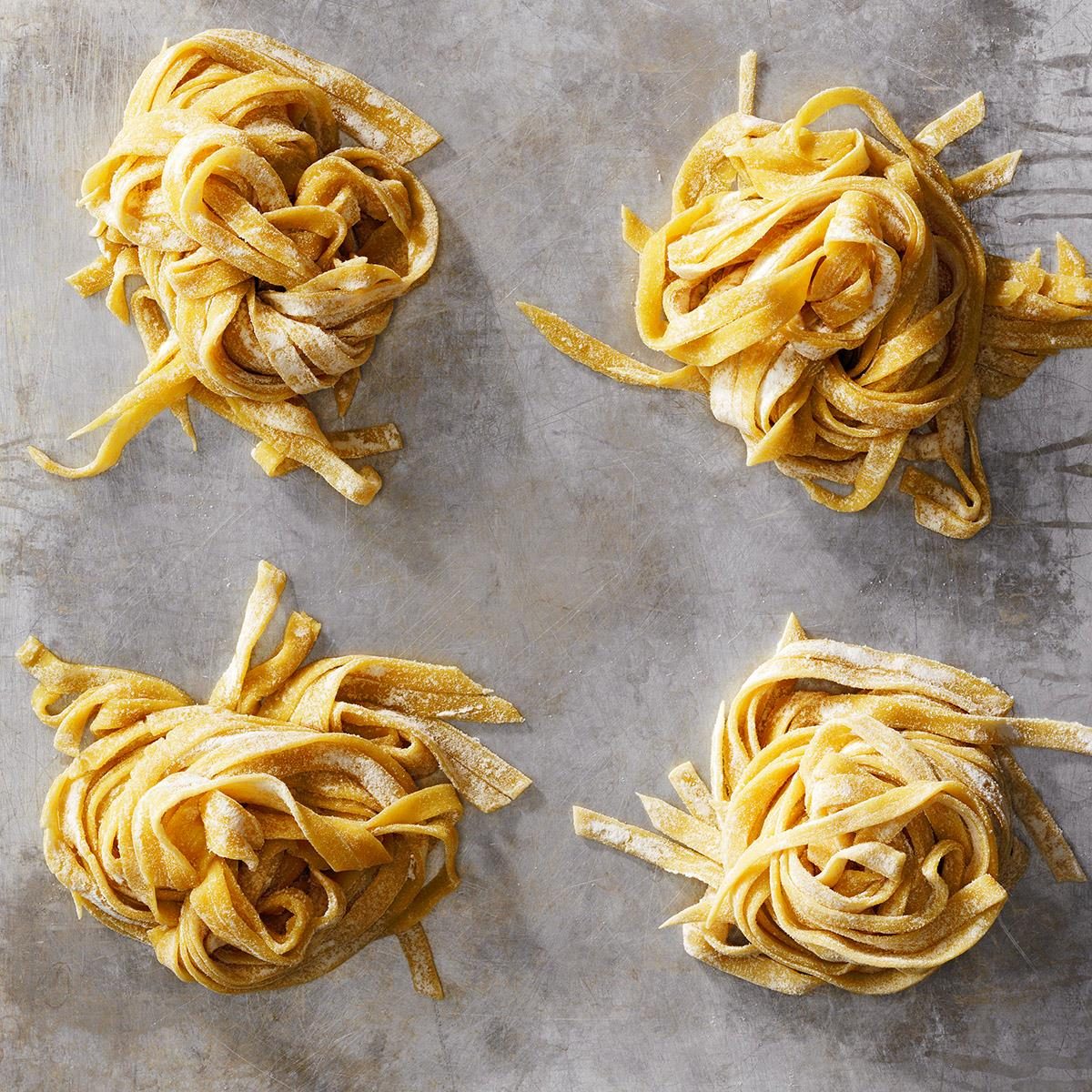The texture and flavor of fresh pasta are superior to boxed pasta, and the dough is surprisingly easy to make. This homemade pasta recipe only requires a few simple pantry ingredients and a rolling pin (but we'll also show you how to make pasta with a stand mixer).

Homemade Pasta

When I think of fresh pasta, my mind jumps to the refrigerated section of a specialty grocery store—and, of course, the cobblestone streets of Italy, where it’s available around every corner. Although you could hop on a plane or take a quick car ride to your nearest grocer, you can also make this fresh homemade pasta recipe from the comfort of your kitchen.
Once you learn how to make homemade pasta, you’ll always look for opportunities to work it into your favorite pasta recipes. It’s quicker and easier than you might think!
How to Make Homemade Pasta
Our homemade pasta dough recipe is perfect for cutting into long pasta shapes, like spaghetti, fettuccine and pappardelle. To make it, you need just a few ingredients: flour, water, eggs and olive oil. We use both all-purpose and semolina flour (a flour made from durum wheat) to give the dough the right texture.
After kneading the dough and letting it rest, you can make the noodles with a rolling pin and a knife. Or, if you plan on making pasta regularly, invest in a stand mixer and stand mixer attachments for rolling and cutting the dough.
For first-time pasta makers, I’d urge you to avoid overthinking it and just have fun. Hit play on a Frank Sinatra-laden playlist and enjoy the old-world technique of making fresh pasta.
Homemade Pasta Ingredients
- Eggs: Our pasta dough recipe calls for two whole eggs plus one egg yolk. The high-protein egg whites help to create structure, while the egg yolks add richness.
- Water: We cut the egg mixture with a bit of water to hydrate the dough.
- Olive oil: You don’t need too much olive oil—just a touch! Olive oil makes the dough smooth, which really helps during the rolling process. It’s especially helpful to prevent sticking if you decide to run your homemade pasta through a stand mixer attachment.
- All-purpose flour: The majority of this pasta dough recipe is made with versatile all-purpose flour. It makes beautifully bouncy noodles, so there’s no need to search high and low for 00 flour!
- Semolina flour: Semolina is a high-gluten flour that helps the pasta become strong and stretchy. Made from durum wheat, this type of flour is a bit coarser than you may be used to, lending a rustic, pleasantly toothsome texture. We’ve found that mixing semolina and all-purpose flour creates a bouncy dough with just enough texture to help the pasta sauce stick to the cooked pasta instead of sliding right off.
Directions
Step 1: Whisk the egg mixture

In a small bowl, whisk the whole eggs, egg yolk, water, olive oil, salt and pepper (if desired). Set the bowl aside.
Step 2: Make the flour mound

On a clean work surface, mix the all-purpose and semolina flours, forming a mound. Make a large well in the center.
Editor’s Tip: If you don’t have semolina flour, you can make this homemade pasta recipe with all-purpose flour only. However, the dough may not stick together quite as well. So, if you do skip the semolina, you may want to cut the dough into shorter shapes, like hand-formed penne or farfalle (bow tie pasta)
Step 3: Add the egg mixture

Pour the egg mixture into the well.
Editor’s Tip: Before you pour, make sure the flour “walls” are high enough so the egg won’t spill out.
Step 4: Mix the dough

Now, the fun part: Using a fork or your fingers, gradually mix the flour into the egg mixture, forming a soft, slightly sticky dough.
Editor’s Tip: Don’t rush this step! Take your time and incorporate the flour little by little, whisking out any chunks of flour before adding more. Going slow in this step will create the smoothest pasta. If any egg mixture escapes the flour wall, use a bench scraper to re-form the walls and bring the liquid back to the center.
Step 5: Knead the dough

Lightly dust your work surface with all-purpose flour. Knead the dough gently five times.
Editor’s Tip: If you took your time when incorporating the flour and egg mixture, you shouldn’t have to knead the dough more than five times. It will already be smooth and supple. If the dough feels rough or shaggy, feel free to continue kneading it for a few minutes.
Step 6: Divide the dough and let it rest

Divide the dough into six portions. Cover and let it rest for 30 minutes.
Editor’s Tip: It’s important to let the dough rest before you continue with the recipe. Resting gives the flour time to hydrate, which helps the dough bind together. Plus, it gives the gluten time to relax, making the pasta dough easier to roll out.
Step 7: Roll out the dough

Roll each ball into a 10×8-inch rectangle with a rolling pin, dusting the dough lightly with all-purpose flour.
Editor’s Tip: You can roll the dough to any thickness. For noodles like fettuccine or linguine, the thinner, the better!
Step 8: Roll up the dough

Roll up the dough jelly-roll style. (That is, starting at a long end and rolling up like a jelly roll cake.)
Step 9: Cut the noodles

With a sharp chef’s knife, cut the roll into 1/4-inch-wide strips for fettuccine. Make broader strips for pappardelle or thinner strips for linguine.
How to Make Homemade Pasta with a Stand Mixer
Step 1: Prep the stand mixer

Prepare the dough as directed and let it rest. (You can also mix and knead dough with a stand mixer using the dough hook). While the dough rests, set up your stand mixer with the pasta roller attachment. Turn the dial on the attachment to the widest setting.
Step 2: Roll the dough using the machine

Cut each dough ball into smaller pieces. Flatten each piece into a small rectangle. Then, feed the dough, short side first, into the roller.
Step 3: Fold the dough and roll again

Fold the dough into thirds to form a rectangle and feed it through the roller. Repeat the process three to four times until the dough feels smooth.
Step 4: Turn the dial and continue rolling

Turn the dial to reduce the opening on the attachment and feed the dough through once or twice. Reduce the opening again, and repeat the process until the desired thickness is achieved.
Editor’s Tip: The dough will get thinner each time you reduce the opening. Doing this process gradually (one dial setting at a time) is the best way to prevent the dough from tearing. If it does tear, don’t fret! Simply fold the dough into thirds to form a rectangle and start again at the widest setting.
Step 5: Attach the noodle cutter

Replace the pasta roller with the noodle-cutting attachment on your stand mixer. Feed the dough through to cut it into individual noodles. Once cut, toss the noodles with flour so they don’t stick together.
Homemade Pasta Serving Suggestions
You can use this homemade pasta recipe with any type of pasta sauce. One great aspect of homemade pasta is that the noodles are so delicious they can do a lot of the heavy lifting flavor-wise. That is to say, you can use them with a lighter sauce that lets the noodle’s flavor shine through. A little butter or olive oil with some cracked pepper and Parmesan (aka cacio e pepe) would do the trick nicely, although heartier sauces are certainly welcome.
If you need some inspiration, here are a few ideas for using homemade pasta. Don’t forget to serve it with a side of garlic bread!
- Keep it simple: Toss the pasta with butter or olive oil and add a little garlic to make garlic spaghetti (it’s perfect for picky eaters!). Or incorporate fresh herbs and vegetables to make recipes like pasta with veggies or shrimp pasta primavera.
- Use a cream sauce: Homemade noodles taste fantastic in creamy pasta recipes like fettuccine Alfredo.
- Incorporate pesto: Make an easy yet elegant dinner by turning your fresh noodles into pesto pasta.
- Make it meaty: You can combine the noodles with any meaty spaghetti sauce. For a restaurant-quality dinner experience at home, cut the dough into 1-inch-thick noodles and make pappardelle Bolognese.
- Turn it into lasagna: Instead of cutting the noodles, leave the pasta in sheet form to make lasagna or lasagna roll-ups.
How to Store Homemade Pasta
It’s best to make your pasta dough and cook it right away. Dried pasta can last for a year or so in the pantry, but uncooked fresh pasta will only last for about a day. Store it in an airtight container in the refrigerator.
Cooked fresh pasta, on the other hand, can be stored in an airtight container in the fridge for up to three days, just like any other pasta recipe.
Can you freeze homemade pasta?
Yes, you can freeze homemade pasta. Place the pasta on a floured baking sheet and freeze for a few hours. Transfer the noodles to an airtight container or a freezer-safe bag. They can be frozen for up to one month.
Here’s the great news about freezing homemade pasta: There’s no need to thaw the noodles before cooking. Simply place the frozen noodles in boiling water. They’ll take a couple extra minutes to cook than unfrozen noodles.
Homemade Pasta Tips

How do you cook fresh pasta?
Cook your fresh pasta noodles in salted boiling water for one to three minutes. Yes, just a few minutes! Fresh pasta doesn’t take nearly as much time to cook as dried pasta. Fresh pasta will never reach al dente, so you’ll want to check your noodles for doneness every 20 to 30 seconds. Cut or bite the pasta and look for a tiny white dot in the center of the noodle. When the dot is gone, they’re done.
Remember to save pasta water when you strain the noodles. This starchy liquid is the key to a silky, rich, beautifully salted pasta sauce. Splash just a touch of this liquid into the saucepan when you toss the pasta with the sauce.
Can you make homemade pasta without eggs?
Yes, you can make homemade pasta without eggs. However, keep in mind that eggs give homemade pasta an undeniable richness and silky mouthfeel. If you choose to skip the eggs in your batch, you can make homemade pasta dough with just flour and water—but know you’re giving up some of that flavor.
Homemade Pasta
Ingredients
- 2 large eggs
- 1 large egg yolk
- 1/4 cup water
- 1 tablespoon olive oil
- 1/4 teaspoon salt
- 1/2 teaspoon coarsely ground pepper, optional
- 1-1/2 cups all-purpose flour
- 1/2 cup semolina flour
Directions
- In a small bowl, whisk first 5 ingredients and, if desired, pepper. On a clean work surface, mix all-purpose and semolina flours, forming a mound. Make a large well in center. Pour egg mixture into well. Using a fork or your fingers, gradually mix flour mixture into egg mixture, forming a soft dough (dough will be slightly sticky).
- Lightly dust work surface with all-purpose flour; knead dough gently 5 times. Divide into 6 portions; cover and let rest 30 minutes.
- To make fettuccine, roll each ball into a 10x8-in. rectangle, dusting lightly with flour. Roll up jelly-roll style. Cut into 1/4-in.-wide strips. Cook in boiling water 1-3 minutes.
Nutrition Facts
1 serving: 217 calories, 5g fat (1g saturated fat), 93mg cholesterol, 124mg sodium, 34g carbohydrate (0 sugars, 1g fiber), 8g protein.





















